 REVIEWED THIS WEEK:
REVIEWED THIS WEEK:
– Detective Comics #809
– Giant Size Spider-Woman #1
– The Tick: Days of Drama #1
– The Losers #26
– Godland #1
– JLA: Classified #10
– Max Hamm: Fairy Tale Detective TPB
– Star Wars: A Long Time Ago vol. 3
– The Flash: Ignition TPB
– The Thing: Freakshow TPB
– Northwest Passage TPB
Oops…Even Vikings Make Mistakes
Just a quick retraction before we move on with regularly scheduled programming. In my review of The Middleman last week, I mistakenly credited Dean Trippe as the artist for the book. Trippe colored the cover. Les McClaine is the book’s artist.
This is particularly embarrassing for me as I had sent out an email to the warrior-scribes about a month ago emphasizing how important it was that we “always get our facts right.” My apologies to McClaine, Viper Comics, you the readers and most importantly my Warrior Scibes.
That said, Loki made me do it!
First Look: Gabrych and Woods Outline War Crimes in “Detective Comics”
By Russell Paulette
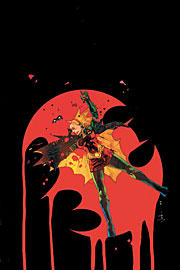 I’m of two minds about crossovers, honestly. On the one hand, the little geek that lives in the heart of me is thrilled at the story so big it can’t be contained in one title. On the other, I’ve been reading and selling comics long enough to catch the stink of marketing and brand reinforcement. In our crossover-happy climate, the thought of yet another crossover just makes me…well, tired, more than anything. To be honest, I’m a just little burnt-out, man.
I’m of two minds about crossovers, honestly. On the one hand, the little geek that lives in the heart of me is thrilled at the story so big it can’t be contained in one title. On the other, I’ve been reading and selling comics long enough to catch the stink of marketing and brand reinforcement. In our crossover-happy climate, the thought of yet another crossover just makes me…well, tired, more than anything. To be honest, I’m a just little burnt-out, man.
Next week marks the latest Bat-Over with Detective Comics # 809, part 1 of War Crimes. Fortunately this one is mercifully short, a four-parter only lasting the month of August, the better to clean the slate before all the DCU shakeups start to hit. Why this editorially mandated sequel to last year’s War Games has to cut Lapham’s superlative Detective Comics arc in half is beyond me—those of you looking for the latest chapter of Lapham’s sordid noir tale are going to have to wait another thirty days. But does that mean you shouldn’t check into what Anderson Gabrych and Pete Woods have in store for you this Wednesday?
Yeah. Probably not. Don’t get me wrong—there’s nothing really wrong with the comic itself. Like I said earlier, the story is a follow-up to last year’s War Games, a crossover notable for lasting a smidge too long and killing off a D-List hero and former also-ran Robin, Stephanie Brown. Otherwise, it was your standard Bat-Over, with little to nothing to praise or decry. It’s the death of Stephanie that serves as the catalyst for War Crimes, when her identity as one of the Robins, as well as her other super-ego, Spoiler, gets outed on broadcast television, along with doubts cast about the nature of the injuries that lead to her death. This leads Batman to the clinic where longtime supporting cast-member Leslie Tompkins works—only she’s taken a powder, along with another clinic physician, and Stephanie’s file. Batman then turns his attention to the man behind the televised revelation, which leads to the accustomed cliffhanger.
As far as the writing goes, Gabrych serves an inoffensive, workable script. Nothing too heinous about it, but nothing particularly stands out either, apart from some of the quieter moments, like the clinic nurse forcing Batman to ask for information with a “please.” Otherwise, the script chugs along raising questions and investing enough in them to hold the reader’s attention. There is one curious scene of Batman actively interfering with a crime-scene—to erase the evidence the killer used to set him up for the crime—which, though explicable is, even for Batman, a bit odd. Either way, it’s perfectly serviceable and, for the most part, finely written.
On the art side, Pete Woods shows his typical deft command of storytelling and pacing. He’s particularly good with facial characterization, and since much of Gabrych’s script calls for scenes that are little more than interviews, Woods excels in conveying each moment effectively. There’s some inkwork by someone named Bit who, to be honest, doesn’t always compliment Woods’s linework. As opposed to, say, Woods in recent issues of Catwoman, the art comes off as a little needlessly busy and crosshatched. Again, it does the job, but little else.
It’s a fine start to a story that will appeal to those steeped in Bat-Lore, and probably not too many others.
TWO AND A HALF OUT OF FIVE VIKINGS

Flashback to the Halcyon Days of Marvel with “Giant-Size Spider-Woman”
By Graig
 Marvel does well with their female counterparts to their male superheroes. They seem to be much more than just clones with boobs. She-Hulk is much different than the Hulk, more so than Batgirl is different than Batman. And while Supergirl and Superman wind up having practically the same origin story, Spider-Woman and Spider-Man, aside from the name, have little in common.
Marvel does well with their female counterparts to their male superheroes. They seem to be much more than just clones with boobs. She-Hulk is much different than the Hulk, more so than Batgirl is different than Batman. And while Supergirl and Superman wind up having practically the same origin story, Spider-Woman and Spider-Man, aside from the name, have little in common.
As a child, Jessica Drew had a fatal disease, which her father cured using an experimental cure which granted her super strength, wall-crawling abilities, and the capability of shooting potent venom, not webs, from her fingers. At a young age, Drew became an agent of Hydra, who trained her to be an elite assassin, but upon discovering the organization’s duplicitous nature, she switched sides and became an ally of S.H.I.E.L.D.
Sadly, Giant-Size Spider-Woman, does not feature the foxy lady in red and yellow growing to 50-foot proportions and taking on city-stomping monsters, instead this is a hyphen-crazy, 94-page offering of Spider-Woman’s back-story. The book reprints her first appearance in Marvel Spotlight, plus the first issue of her ongoing series and, for good measure, the 2-issue X-Men appearance later on in her series. The first two stories (and it seems much of her early adventures) had Spider-Woman searching for the truth about her past, and for her own identity. By the time she hooked up with the X-Men, Spider-Woman knew she was Jessica Drew, but had no real life to speak of, so she started a detective agency.
The book opens with an 8-page “all-new story by Brian Michael Bendis and Rick Mays” which acts as a prelude to Spider-Woman’s appearance in the New Avengers title. Jessica Drew is without her powers and is struggling as a detective when a strange man gives her a fresh costume and offers her back her powers, at a cost. It’s a frustrating non-story that quite obviously is an advertisement for the Avengers series. But the overall package implies that Marvel is poising Spider-Woman as a breakout character and this is the jumping-on point.
With stories by Archie Goodwin, Marv Wolfman and Chris Claremont, and art by Sal Buscema, Carmine Infantino and Steve Leialoha, these may not be the most fondly remembered tales, but they are classic Marvel, through and through and probably as close as your going to get to an Essential Spider-Woman compilation. The book is a winner for its classic material and a nifty character, making me wonder where the lady’s been and why she’s been sitting on the shelf for so long. It serves as a decent cold-start for new fans and a good refresher for old. But I can imagine the fanboys picking it up for the Bendis/Avengers factor are going to be disappointed.
THREE OUT OF FIVE VIKINGS

“The Tick” is Back in “Days Of Drama”… But Will We Recognize Him?
By Rob Glenn
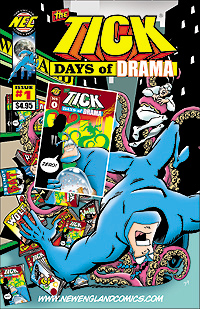 1988. The first Tick comic hits the stands. The public was introduced to a large man in blue full-body tights and interlocking triangles forming his antennae. His creator Ben Edlund made the brilliant decision to have our first image of this man wearing a straightjacket in a literal rubber room. Clever in that for the rest of the series the audience was never sure if what we were reading was “actual” events or the hallucinations of a crazed man suffering from a superhero-colored dementia. The Tick’s speech was verbose, innocent, and preoccupied with justice like a jumble of half-remembered monologues picked from various Golden Age comics. Even the characters he met trying to defend “The City” had more than passing resemblances to pre-existing characters. There was a Batman-esque man calling himself Die Fledermaus. Elektra’s twin went by the apropos moniker of Oedipus. The Running Guy held tightest to the possible none-of-this-is-really-happening angle as he could be a Flash parody or just a guy out exercising whom The Tick incorporates into his psychosis.
1988. The first Tick comic hits the stands. The public was introduced to a large man in blue full-body tights and interlocking triangles forming his antennae. His creator Ben Edlund made the brilliant decision to have our first image of this man wearing a straightjacket in a literal rubber room. Clever in that for the rest of the series the audience was never sure if what we were reading was “actual” events or the hallucinations of a crazed man suffering from a superhero-colored dementia. The Tick’s speech was verbose, innocent, and preoccupied with justice like a jumble of half-remembered monologues picked from various Golden Age comics. Even the characters he met trying to defend “The City” had more than passing resemblances to pre-existing characters. There was a Batman-esque man calling himself Die Fledermaus. Elektra’s twin went by the apropos moniker of Oedipus. The Running Guy held tightest to the possible none-of-this-is-really-happening angle as he could be a Flash parody or just a guy out exercising whom The Tick incorporates into his psychosis.
After the twelfth issue, Ben Edlund passed the reins onto a new group of artists. The book had become a decent money-maker for New England Comics and spawned two spin-offs: Paul the Samurai and The Man-Eating Cow. At this point any hope that the story will end with a Shyamalan-like twist where we find all the previous events were a fevered dream are moot. Hallucinations never go off to live their own lives. In 1994, the Fox Network opted to turn the comic into an animated series and the first of thirty-six episodes aired. Most fans of the character agree that overall it was a decent adaptation, helped a lot by the show’s habit of using actual storylines from the comic. 2001 saw The Tick in live action form. Patrick Warburton was the perfect choice to bring The Tick to life in theory. Unfortunately his performance came off as less insane and more, well, drunk. In yet another instance of weird bureaucracy infringing on art, character names used in the Fox cartoon were tied up in red tape and therefore couldn’t be used in the latest version… on Fox. American Maid had to be a less punny Captain Liberty. Die Fledermaus was transformed to the obvious Batmanuel, losing the opera reference altogether.
Then there was nothing. Only nine episodes of the live action show were produced and then it was mercifully pulled from the schedule. We have been Tickless for over three years. Edlund has gone on to work many projects with Joss Whedon and even wrote an episode of the outstanding The Venture Bros.
New England Comics, knowing they still have a viable property on their hands, has brought The Tick back in a new series: Days of Drama. Issue # 1 is sitting on your local comic shop’s shelf even as I write this. In an effort to give more bang for the customer ensnarement, issue one is not just one but three comics. Attached to the cover is a mini-comic calling itself “No. 0”. At eight pages long and measuring 3½ by 2¼ inches, there is only just enough time to have The Tick wake up from a foreboding dream calling him back to The City. The real story starts in the issue proper. Playing on the book’s absence from the comic scene, we are reintroduced to The Tick and his sidekick Arthur after they return from
Edlund is still not directly involved and frankly it shows. Absent is any hint of delirium. This story is to be taken at face value. Thankfully there are still some classic touches present. The Tick’s new neighbor in the Stepford-like Blissburg is a man who mows his lawn at all hours completely nude. Then there are the instances where you wonder if the new creative team even gets it such as the bad guy who snatches a purse called “The Snatcher”. The art is also a little more cartoon-y than the original series was. Minor characters like a local cop look like they belong in another book altogether and stick out next to a comparatively realistically drawn Tick.
The third comic-within-a-comic is the simplistically drawn “Tick & Artie” found at the back of the book. The Tick fights a bad guy named Bull Beetle and the story ends with a decidedly non-Tick ending with our blue man performing a sneaky trick.
As negative as my review sounds, I’m not ready to give up on this series yet. My theory is that the crew responsible has thrown out these three stories in a hurry trying to meet a deadline. Evidence of this might be taken from a word balloon on page seven pointing to the wrong character. If this is the case, and what we have now is a rush job, then this series could improve tremendously in the following issues. I plan on sticking around to at least # 4 where the cover looks like a Tenacious D album. Perhaps by then a little edge will have been brought back.
TWO OUT OF FIVE VIKINGS

Diggle and Wilson Provide Action and Suspense in Latest “Losers” Arc
By Russell Paulette
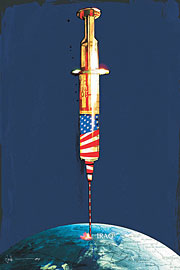 Despite it’s marked quality, you can’t help but feel that Andy Diggle’s action/conspiracy Vertigo epic The Losers has only just hit issue # 26 as DC’s thank-you to Diggle for making people give a damn about Adam Strange. This is just a book nobody talks about anymore and it’s a shame, because with its mix of contemporary paranoiac politics, mish-mash pop-internet-culture, and kick-ass gunplay, you would think this would be a book more people would check out.
Despite it’s marked quality, you can’t help but feel that Andy Diggle’s action/conspiracy Vertigo epic The Losers has only just hit issue # 26 as DC’s thank-you to Diggle for making people give a damn about Adam Strange. This is just a book nobody talks about anymore and it’s a shame, because with its mix of contemporary paranoiac politics, mish-mash pop-internet-culture, and kick-ass gunplay, you would think this would be a book more people would check out.
Sadly, that’s not the case and, as such, the book also feels like it’s rounding third into the home stretch and doing so for the devotees who have been following the book for its whole trip around the diamond. A kind of thank-you from Diggle to us long-term readers for sticking with him this long.
The story? Max, the mysterious, CIA powerbroker the rogue commando team have been hunting the whole time has gotten his hands on some nukes, and the team have trailed them to an abandoned city in the Ukraine— due to Chernobyl fallout, it’s the best place in the world for Max to hide his stolen nuclear arms. They storm into the abandoned city meeting plenty of heavy resistance, while Max unveils his plan in a televised broadcast from the middle of the
Truly an original, inventive script, Diggle juggles the plausible with the action-movie silly with enough adroitness that he keeps this book endlessly entertaining. Often stressing the “techno” in “techno-thriller,” Diggle out-Clancy’s Clancy and gives us a mostly-accessible, adrenaline-fuled, testosterone packed, squad-level combat potboiler, and he does it in style. Easily one of my favorite books every month, this is what the A-Team would look like if it were broadcast on HBO. Hyperbole aside, this issue isn’t terribly accessible if you’re jumping on without having read any of the previous issues, or if you’re just coming from the trades. While there are plenty of opportunities for contextual exposition, though, and it should pack enough of a punch to make you go check out the trades, that’s for sure. But at this point in the series, Diggle is swinging for the rafters, and doesn’t seem too concerned with giving the readers a scorecard.
Since this latest issue is the first part of a new storyarc called Un-America, the book also offers the European stylings of Colin Wilson—last seen on these shores in Brubaker’s fantastic Sleeper prelude, Point Blank. An admitted departure from the regular artist, Jock,
Though not particularly accessible, but eminently readable, Diggle offers a lot of gunplay and conspiracy fun in this latest issue. If you’re looking for dudes with guns and crazy CIA-fuled machinations, The Losers is the right book for you—just be warned that we’re knee-deep in the plot, and running through all the twists and turns its taken to get here would sacrifice valuable real estate that Diggle, instead, spends with the shootin’.
THREE AND A HALF OUT OF FIVE VIKINGS

For Casey and Scioli, Cleanliness is Next to “Godland”
By Russell Paulette
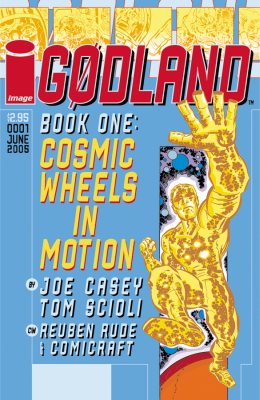 Well, to answer your second question about Joe Casey and Tom Scioli’s new Image ongoing series, Godland: Yes, Scioli is the one who draws like the King, and he draws a nifty modern-homage to Jack Kirby, and with plenty of style. To answer your first question about the new creator-owned super-hero title: Yes, it is good. Quite good. And, perhaps to the relief of a good portion of our audience, quite fun.
Well, to answer your second question about Joe Casey and Tom Scioli’s new Image ongoing series, Godland: Yes, Scioli is the one who draws like the King, and he draws a nifty modern-homage to Jack Kirby, and with plenty of style. To answer your first question about the new creator-owned super-hero title: Yes, it is good. Quite good. And, perhaps to the relief of a good portion of our audience, quite fun.
Casey and Scioli’s effort details the saga of Commander Adam Archer, a former NASA astronaut who encountered something weird on a manned mission to Mars, and came back with starlight powers. Now he does what anyone would do in that situation—he lives in the government-built
Writing in both a starry-eyed homage mode of sixties Marvel, as well as a tongue-in-cheek, postmodernist send-up, Casey turns out a script that is spare as it is spectacular, and carefully crafted. It’s the kind of script that makes you believe the humanity of this intergalactic adventurer, while still giving you the crazy Kirby machines and Alien Dogs for Archer to fight. He provides you with the customary Army Colonels and (presumably) villainous, gun-toting mad scientists—but he does so with a manic, McSweeney’s glee. One of the best moments was his having said villain answer the question “who are you?” with “are you asking my name…or are you asking if I’m at all existentially aware?” That, right there, pretty much nails the tone and tenor of the writing. It’s at once fun and freewheeling, as it is self-conscious and brushing—but never quite breaking—the fourth wall.
On the art front, much has been made of Scioli’s contribution. He’s known as a Kirby devotee, and his linework shows that comparison in spades. His art has that Kirby tendency to draw a relief shadow with a squiggly, worm-line down the shaded side of his forms. Scioli’s design work looks cribbed straight from volumes of Essential Fantastic Four. As far as his depictions of cosmic, solar energy, it’s straight from the Kirby school of hollow forms emanating blast lines and clouds of baubled black dots. That said, there’s something fresh and innovative about his work—some of his pages are more open and spare than I remember Jack’s being, and his storytelling retains that manic energy without aping panel arrangements or composition. In short, this is an artist who has the design sense of the King, without resorting to outright theft—and that, really, is the mark of someone who’s absorbed his influence into a style he can safely call his own.
An auspicious debut, the other key word to the book is fun. This is a book that, while feeling like a Silver Age Stan Lee script, doesn’t suffer from embarrassing excesses of tribute and, instead, rises above into a synthesis of styles. This is Casey, tongue firmly in his cheek, giving us a Sixties Pop comic with postmodern sensibilities and I, for one, ate it up—and you should, too.
FOUR AND A HALF OUT OF FIVE VIKINGS

Ellis and Guice Take on the Justice League in “JLA: Classified”
By Russell Paulette
 Proving once again how adept he is at a genre he publicly loathes, Warren Ellis jumps on-board DC’s rotating-talent-title, JLA: Cassified, for part one of his arc “New Maps of Hell.” Starting with artist Butch Guice on issue # 10, Ellis has his best foot forward and his finger firmly on the big red button of the Wayback Machine, getting us firmly into the more settled continuity of a year or so ago.
Proving once again how adept he is at a genre he publicly loathes, Warren Ellis jumps on-board DC’s rotating-talent-title, JLA: Cassified, for part one of his arc “New Maps of Hell.” Starting with artist Butch Guice on issue # 10, Ellis has his best foot forward and his finger firmly on the big red button of the Wayback Machine, getting us firmly into the more settled continuity of a year or so ago.
The story kicks off with a suicide in Metropolis—one that Superman is unable to prevent, which is the stated point of the victim. Clark Kent and Lois Lane arrive on the scene the next morning and do their investigative reporting thing, trying to track down the link between this dead guy and three other suicides in the last few weeks—seems all of them were LexCorp employees. Meanwhile, in
The story is intriguing enough, especially in the way that Ellis starts the events small and lets them snowball until it becomes clear that the problem is of League-sized proportions. Some of the best moments, though, come with the
Guice’s artwork is superlative, with an incredible grasp of not only mood and atmosphere, but also of storytelling and pacing. His rendering is particularly delightful, as he’s one of those rare artists who not only draw realistic and distinctive looking faces, but he also does so without obvious photo-referencing or shameless actor-modeling. Yes, everyone looks like a distinctive person, and refreshingly not one whose name headlines the marquees at the local Cineplex. He draws a fierce, imposing Batman, his
An intriguing set of ideas from a talented writer and a craftsman of an artist, the latest JLA: Classified suffers only from an unsightly, computer-rendered cover that’s as ugly as it is distorted and plastic-looking. Save that one blemish, this is a great start to what looks like an excellent arc, and one well worth checking out.
FOUR OUT OF FIVE VIKINGS


Artistically Impressive and a Genuine Delight, “Max Hamm” is a Clever Hardboiled Fairytale
By Sean Fahey
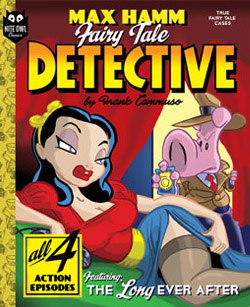 Max Hamm Fairy Tale Detective is the most surprising comic book I’ve read this year. Pleasantly surprising I might add. Knocked on my fanny surprising in fact. Originally, I was expecting a cute little homage to some of the more innocent elements of crime fiction told against the backdrop of some classic fairytales and nursery rhymes. Boy was I wrong. While Max Hamm certainly combines the aforementioned influences to detail the misadventures of Storybook Lands’ most unique private detective, it’s anything but an “homage,” it’s certainly not “little” and to dismiss it as “cute” is an insult to the book – a beautiful, charming, clever and exceptionally well written piece of hardboiled detective fiction with a fairytale twist.
Max Hamm Fairy Tale Detective is the most surprising comic book I’ve read this year. Pleasantly surprising I might add. Knocked on my fanny surprising in fact. Originally, I was expecting a cute little homage to some of the more innocent elements of crime fiction told against the backdrop of some classic fairytales and nursery rhymes. Boy was I wrong. While Max Hamm certainly combines the aforementioned influences to detail the misadventures of Storybook Lands’ most unique private detective, it’s anything but an “homage,” it’s certainly not “little” and to dismiss it as “cute” is an insult to the book – a beautiful, charming, clever and exceptionally well written piece of hardboiled detective fiction with a fairytale twist.
It’s impossible not to be immediately smitten with Frank Cammuso’s gorgeous artwork here. His characters and settings are expertly rendered with exceptional style and detail, especially in the work’s gray-wash painted sequences. And by modeling the look of Max Hamm on the animation style of the period he is trying to evoke (1930’s Hollywood, think classic Warner Brothers cartoons), Cammuso is able to instantly transport the reader to his story setting and establish the requisite mood. His dames are to kill for. His heavies are as tough as nails, and his unique urban setting evokes both the innocence and magic of fairytales and the unforgiving callousness of the naked city. In every way it’s a smart visual scheme, made smarter by the brilliant prose accompanying it.
Cammuso’s mastery of language is exceptional. It’s no wonder the man was nominated for an Eisner in recognition of his work here. Just about every single line in Max Hamm is an expertly crafted metaphor or pun that plays on the conventions of both classic hardboiled noir fiction and nursery rhymes simultaneously. There’s a tremendous rhythm and cadence to the work here that is so incredible rich – equal parts Philip Marlowe voice over and Mother Goose. Put simply, this is some of the most cleverly written prose I’ve read in a while. Max Hamm not only honors the literary traditions it works to evoke, it puts itself in their company.
As artistically impressive as the work is, Max Hamm is also just delight to read. The characterizations are charming…in a hardboiled kind of way. Snow White as a lounge singer. King Cole as a club owner. Humpty Dumpty as
FIVE OUT OF FIVE VIKINGS

Star Wars: A Long Time Ago… Volume 3: Resurrection of Evil
By Graig
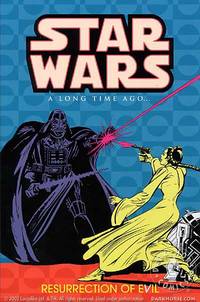 Now that Episode Three has come and gone, is Star Wars officially played out? Are we tired and done with it? Lucas has toyed with our affections and tampered with our memories, are we a little bitter and want nothing else to do with his creation? Perhaps. It’s hard for us in the Star Wars generation to look back upon the original trilogy without some sort of convulsion of anger thanks to Lucas’ digital tinkering. But some memories can be left as they were, as Dark Horse has collected all 107 issues of Marvel’s Star Wars series in 7 massive trade paperbacks without recoloring, re-editing, or really any other tinkering. It’s a healthy dose of nostalgia, but is it any good?
Now that Episode Three has come and gone, is Star Wars officially played out? Are we tired and done with it? Lucas has toyed with our affections and tampered with our memories, are we a little bitter and want nothing else to do with his creation? Perhaps. It’s hard for us in the Star Wars generation to look back upon the original trilogy without some sort of convulsion of anger thanks to Lucas’ digital tinkering. But some memories can be left as they were, as Dark Horse has collected all 107 issues of Marvel’s Star Wars series in 7 massive trade paperbacks without recoloring, re-editing, or really any other tinkering. It’s a healthy dose of nostalgia, but is it any good?
This third volume kicks off with the best film-to-comic adaptation ever, as Al Williamson and Archie Goodwin present the Empire Strikes Back. From there the series, as it did previously, loses most of its connection to the Star Wars universe. Even though Lando and Chewie search for Han, and Luke and Leia search for a new rebel base, the editorial restrictions scream “No character growth or plot advancement” which just leaves the series with a gaggle of Battlestar Galactica-style space-faring, planet-exploring action, adding a slew of Vader near-misses and a host of cornball new characters in 1980’s “future fashion”. Post-adaptation art chores by Carmine Infantino (with, sadly, some really bad ink jobs) transition to Walt Simonson, and it’s generally good stuff, but the writing is of the goofy old “exposition-said-aloud” manner by Goodwin, Larry Hama, Mike Barr, David Micheline and Chris Claremont. In the end, this book is kind of so bad it’s good, as long as you resolve that it’s not really Star Wars you’re reading. [Note: these volumes are rather expensive, but I’ve been finding them on discount racks all over the place.]
THREE OUT OF FIVE VIKINGS

The Flash: Ignition
By Graig
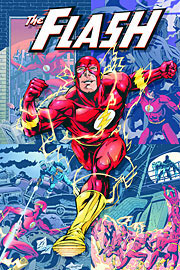 Amidst an ever more complex and interweaving series of tales, writer Geoff Johns takes The Flash for a time-out with Ignition, collecting issues 201 to 206. As is explained, the Flash’s wife has just had a miscarriage due to the actions of one of Wally West’s foes, and because of his not-so-secret identity. So Wally asks Hal Jordan, the Spectre, to erase everyone’s memory of him being the Flash, the only catch is, Hal erases Wally’s memory as well.
Amidst an ever more complex and interweaving series of tales, writer Geoff Johns takes The Flash for a time-out with Ignition, collecting issues 201 to 206. As is explained, the Flash’s wife has just had a miscarriage due to the actions of one of Wally West’s foes, and because of his not-so-secret identity. So Wally asks Hal Jordan, the Spectre, to erase everyone’s memory of him being the Flash, the only catch is, Hal erases Wally’s memory as well.
Ignition picks up with Wally working as a grease monkey for the Keystone City Police, and the Flash has been missing for two months. Wally’s world gets shaken up as he begins to rediscover his powers, but not his memories, while one of the Flash’s old Rogue’s has reappeared on a murderous rampage. It’s very much an origin story without eliminating his true origin, and it’s rather clever. The only trouble is, the carefree Wally West is gone, and I’m not sure the more serious Wally is an acceptable replacement.
John’s has been doing a fine job carrying on the Flash legacy, and with Ignition he’s created the perfect jumping-on point for new readers. The art by Alberto Dose is similar to 100 Bullets’ Eduardo Risso but not nearly as skilled. Heavy on shadows, his plainclothes are good, but his men-in-spandex are really awkward looking (and his Batman is just plain ugly). It surprised me to find that this also serves as a precursor to the events set in motion in Identity Crisis, alluding to some of that series’ themes.
THREE AND A HALF OUT OF FIVE VIKINGS

The Thing: Freakshow
By Graig
 So the Fantastic Four movie is pulling in decent numbers and is surprisingly quite passable entertainment, but it’s hardly making any big names out of its cast. But, if it were going to be a star-making vehicle for anyone, it would not be the actor Michael Chiklis, but rather his character, The Thing. Even the hardest of die-hard fan has to admit, they got him right.
So the Fantastic Four movie is pulling in decent numbers and is surprisingly quite passable entertainment, but it’s hardly making any big names out of its cast. But, if it were going to be a star-making vehicle for anyone, it would not be the actor Michael Chiklis, but rather his character, The Thing. Even the hardest of die-hard fan has to admit, they got him right.
So if anyone wanted more Thing without the fantastic other three, this is currently their only option on the trade paperback rack. Collecting the four-issue Freakshow mini, brooding Ben Grimm lashes out at his teammates and hits the rails for a vacation, winding up in a backwards small-town where multiple elements of Ben’s past conveniently collide. Krees, Skrulls, and sideshow freaks converge and naturally Ben’s the one to sort it all out. Written by Geoff Johns, Freakshow contains a lot of conveniences that make the story a little hard to gently swallow. It’s fluffy and slightly humorous reading, with heavily detailed artwork by Scott Kolins. Inkers Doug Hazlewood and Andy Lanning seemed to avoid shadow in accentuating Kolins pencils, making fore and backgrounds difficult to distinguish and the pages looking too busy.
A second feature in the book pairs the Thing with She-Hulk, as bomb explodes in a subway tunnel (odd reading lately), unwittingly letting loose the Dragon Man from his chamber where he’s been experimented on by a clandestine operation. Vampires, evil scientists and the Dragon Man all get in the way of Thing and She-Hulk rescuing the subway passengers. It’s goofy, over-the-top mayhem by Todd Dezago with passable but slightly awkward art from (strangely enough) pencilers Bryan Hitch and Ivan Reis with inks by Paul Neary and Randy Emberlin. Freakshow is passable entertainment, but for more Thing I’d rather have a cheap “Essential” collection of Marvel Two-In-One.
TWO AND A HALF OUT OF FIVE VIKINGS

A Canadian Western? Believe it, “The Northwest Passage” is an Exciting Tale of High Adventure
By Sean Fahey
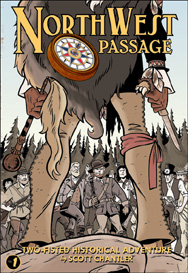 The diversity of material in comics today is impressive, especially when compared to what the industry looked like ten years ago. Don’t get me wrong, I like my superheroes. But it’s refreshing to find something new on the stands. Something unique to the market. Something like The Northwest Passage – a good old-fashioned tale of adventure and excitement in the Canadian West.
The diversity of material in comics today is impressive, especially when compared to what the industry looked like ten years ago. Don’t get me wrong, I like my superheroes. But it’s refreshing to find something new on the stands. Something unique to the market. Something like The Northwest Passage – a good old-fashioned tale of adventure and excitement in the Canadian West.
That’s right